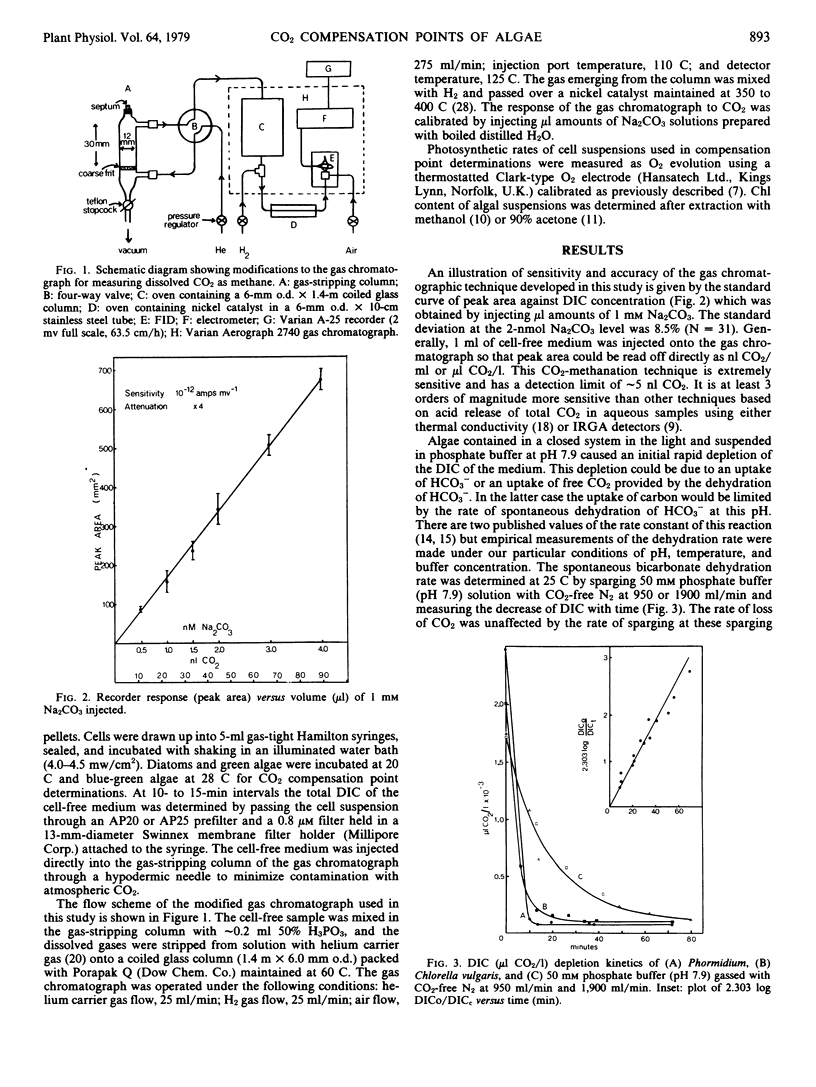Abstract
A technique is described for the measurement of total dissolved inorganic carbon by acid release as CO2 followed by its conversion to methane and detection by flame ionization in a modified gas chromatograph. This method was used to determine the dissolved inorganic carbon concentration reached at compensation point when algae were allowed to photosynthesize in a closed system in a buffer at known pH, and the CO2 compensation point was calculated from this concentration. The CO2 compensation points of 16 freshwater algae were measured at acid and alkaline pH in air-saturated medium: at acid pH the CO2 compensation points ranged from 4.8 to 41.5 microliters per liter while at alkaline pH they ranged from 0.2 to 7.2 microliters per liter. Removal of O2 from the medium caused a slight lowering of compensation point at acid pH but had little effect at alkaline pH. These low, O2-insensitive compensation points are characteristic of C4 plants. It is suggested that these low CO2 compensation points are maintained by an active bicarbonate uptake by algae especially at alkaline pH.
Full text
PDF



Selected References
These references are in PubMed. This may not be the complete list of references from this article.
- Lloyd N. D., Canvin D. T., Culver D. A. Photosynthesis and photorespiration in algae. Plant Physiol. 1977 May;59(5):936–940. doi: 10.1104/pp.59.5.936. [DOI] [PMC free article] [PubMed] [Google Scholar]
- Magid E., Turbeck B. O. The rates of the spontaneous hydration of CO2 and the reciprocal reaction in neutral aqueous solutions between 0 degrees and 38 degrees. Biochim Biophys Acta. 1968 Oct 15;165(3):515–524. doi: 10.1016/0304-4165(68)90232-8. [DOI] [PubMed] [Google Scholar]
- TURNER J. S., BRITTAIN E. G. Oxygen as a factor in photosynthesis. Biol Rev Camb Philos Soc. 1962 Feb;37:130–170. doi: 10.1111/j.1469-185x.1962.tb01607.x. [DOI] [PubMed] [Google Scholar]
- Van T. K., Haller W. T., Bowes G. Comparison of the photosynthetic characteristics of three submersed aquatic plants. Plant Physiol. 1976 Dec;58(6):761–768. doi: 10.1104/pp.58.6.761. [DOI] [PMC free article] [PubMed] [Google Scholar]
- WHITTINGHAM C. P. Rate of photosynthesis and concentration of carbon dioxide in Chlorella. Nature. 1952 Dec 13;170(4337):1017–1018. doi: 10.1038/1701017b0. [DOI] [PubMed] [Google Scholar]
- Williams F. W., Woods F. J., Umstead M. E. Determination of carbon dioxide in the parts-per-million range with gas chromatography. J Chromatogr Sci. 1972 Sep;10(9):570–572. doi: 10.1093/chromsci/10.9.570. [DOI] [PubMed] [Google Scholar]


